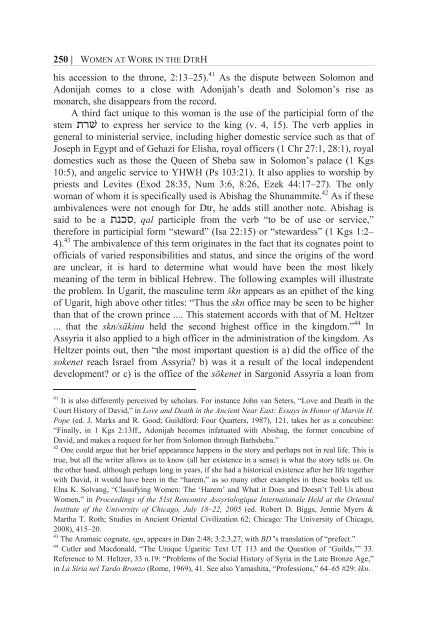Women at Work in the Deuteronomistic History - International Voices ...
Women at Work in the Deuteronomistic History - International Voices ...
Women at Work in the Deuteronomistic History - International Voices ...
Create successful ePaper yourself
Turn your PDF publications into a flip-book with our unique Google optimized e-Paper software.
250 | WOMEN AT WORK IN THE DTRH<br />
his accession to <strong>the</strong> throne, 2:13–25). 41 As <strong>the</strong> dispute between Solomon and<br />
Adonijah comes to a close with Adonijah’s de<strong>at</strong>h and Solomon’s rise as<br />
monarch, she disappears from <strong>the</strong> record.<br />
A third fact unique to this woman is <strong>the</strong> use of <strong>the</strong> participial form of <strong>the</strong><br />
stem תרשׁ to express her service to <strong>the</strong> k<strong>in</strong>g (v. 4, 15). The verb applies <strong>in</strong><br />
general to m<strong>in</strong>isterial service, <strong>in</strong>clud<strong>in</strong>g higher domestic service such as th<strong>at</strong> of<br />
Joseph <strong>in</strong> Egypt and of Gehazi for Elisha, royal officers (1 Chr 27:1, 28:1), royal<br />
domestics such as those <strong>the</strong> Queen of Sheba saw <strong>in</strong> Solomon’s palace (1 Kgs<br />
10:5), and angelic service to YHWH (Ps 103:21). It also applies to worship by<br />
priests and Levites (Exod 28:35, Num 3:6, 8:26, Ezek 44:17–27). The only<br />
woman of whom it is specifically used is Abishag <strong>the</strong> Shunammite. 42 As if <strong>the</strong>se<br />
ambivalences were not enough for Dtr, he adds still ano<strong>the</strong>r note. Abishag is<br />
said to be a תנכס, qal participle from <strong>the</strong> verb “to be of use or service,”<br />
<strong>the</strong>refore <strong>in</strong> participial form “steward” (Isa 22:15) or “stewardess” (1 Kgs 1:2–<br />
4). 43 The ambivalence of this term orig<strong>in</strong><strong>at</strong>es <strong>in</strong> <strong>the</strong> fact th<strong>at</strong> its cogn<strong>at</strong>es po<strong>in</strong>t to<br />
officials of varied responsibilities and st<strong>at</strong>us, and s<strong>in</strong>ce <strong>the</strong> orig<strong>in</strong>s of <strong>the</strong> word<br />
are unclear, it is hard to determ<strong>in</strong>e wh<strong>at</strong> would have been <strong>the</strong> most likely<br />
mean<strong>in</strong>g of <strong>the</strong> term <strong>in</strong> biblical Hebrew. The follow<strong>in</strong>g examples will illustr<strong>at</strong>e<br />
<strong>the</strong> problem. In Ugarit, <strong>the</strong> mascul<strong>in</strong>e term škn appears as an epi<strong>the</strong>t of <strong>the</strong> k<strong>in</strong>g<br />
of Ugarit, high above o<strong>the</strong>r titles: “Thus <strong>the</strong> skn office may be seen to be higher<br />
than th<strong>at</strong> of <strong>the</strong> crown pr<strong>in</strong>ce .... This st<strong>at</strong>ement accords with th<strong>at</strong> of M. Heltzer<br />
... th<strong>at</strong> <strong>the</strong> skn/sāk<strong>in</strong>u held <strong>the</strong> second highest office <strong>in</strong> <strong>the</strong> k<strong>in</strong>gdom.” 44 In<br />
Assyria it also applied to a high officer <strong>in</strong> <strong>the</strong> adm<strong>in</strong>istr<strong>at</strong>ion of <strong>the</strong> k<strong>in</strong>gdom. As<br />
Heltzer po<strong>in</strong>ts out, <strong>the</strong>n “<strong>the</strong> most important question is a) did <strong>the</strong> office of <strong>the</strong><br />
sokenet reach Israel from Assyria? b) was it a result of <strong>the</strong> local <strong>in</strong>dependent<br />
development? or c) is <strong>the</strong> office of <strong>the</strong> sōkenet <strong>in</strong> Sargonid Assyria a loan from<br />
41 It is also differently perceived by scholars. For <strong>in</strong>stance John van Seters, “Love and De<strong>at</strong>h <strong>in</strong> <strong>the</strong><br />
Court <strong>History</strong> of David,” <strong>in</strong> Love and De<strong>at</strong>h <strong>in</strong> <strong>the</strong> Ancient Near East: Essays <strong>in</strong> Honor of Marv<strong>in</strong> H.<br />
Pope (ed. J. Marks and R. Good; Guildford: Four Quarters, 1987), 121, takes her as a concub<strong>in</strong>e:<br />
“F<strong>in</strong>ally, <strong>in</strong> 1 Kgs 2:13ff., Adonijah becomes <strong>in</strong>f<strong>at</strong>u<strong>at</strong>ed with Abishag, <strong>the</strong> former concub<strong>in</strong>e of<br />
David, and makes a request for her from Solomon through B<strong>at</strong>hsheba.”<br />
42 One could argue th<strong>at</strong> her brief appearance happens <strong>in</strong> <strong>the</strong> story and perhaps not <strong>in</strong> real life. This is<br />
true, but all <strong>the</strong> writer allows us to know (all her existence <strong>in</strong> a sense) is wh<strong>at</strong> <strong>the</strong> story tells us. On<br />
<strong>the</strong> o<strong>the</strong>r hand, although perhaps long <strong>in</strong> years, if she had a historical existence after her life toge<strong>the</strong>r<br />
with David, it would have been <strong>in</strong> <strong>the</strong> “harem,” as so many o<strong>the</strong>r examples <strong>in</strong> <strong>the</strong>se books tell us.<br />
Elna K. Solvang, “Classify<strong>in</strong>g <strong>Women</strong>: The ‘Harem’ and Wh<strong>at</strong> it Does and Doesn’t Tell Us about<br />
<strong>Women</strong>,” <strong>in</strong> Proceed<strong>in</strong>gs of <strong>the</strong> 51st Rencontre Assyriologique Intern<strong>at</strong>ionale Held <strong>at</strong> <strong>the</strong> Oriental<br />
Institute of <strong>the</strong> University of Chicago, July 18–22, 2005 (ed. Robert D. Biggs, Jennie Myers &<br />
Martha T. Roth; Studies <strong>in</strong> Ancient Oriental Civiliz<strong>at</strong>ion 62; Chicago: The University of Chicago,<br />
2008), 415–20.<br />
43 The Aramaic cogn<strong>at</strong>e, sgn, appears <strong>in</strong> Dan 2:48; 3:2,3,27, with BD’'s transl<strong>at</strong>ion of “prefect.”<br />
44 Cutler and Macdonald, “The Unique Ugaritic Text UT 113 and <strong>the</strong> Question of ‘Guilds,’” 33.<br />
Reference to M. Heltzer, 33 n.19: “Problems of <strong>the</strong> Social <strong>History</strong> of Syria <strong>in</strong> <strong>the</strong> L<strong>at</strong>e Bronze Age,”<br />
<strong>in</strong> La Siria nel Tardo Bronzo (Rome, 1969), 41. See also Yamashita, “Professions,” 64–65 #29: škn.




